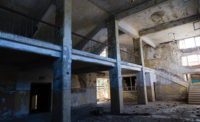Date current version adopted
NFPA 652 was issued on August 18, 2015, and became effective on September 7, 2015. The standard provides requirements for managing combustible dust fire and explosion hazards. It directs the users to appropriate NFPA industry or commodity-specific standards by establishing a relationship and hierarchy between them. These industry or commodity-specific standards are: NFPA 61, NFPA 484, NFPA 655, NFPA 654, and NFPA 664.
If requirements in an industry or commodity-specific NFPA standard differ from or specifically prohibit the requirement in NFPA 652, requirements in the industry or commodity-specific NFPA standard shall be permitted. If an industry or commodity-specific NFPA standard neither prohibits nor provides a requirement, then the requirement in NFPA 652 shall apply.
Hazards addressed
Any combustible material can burn rapidly when in a finely divided form. If such a dust is suspended in air in the right concentration, under certain conditions it can become explosive. Even materials that do not burn in larger pieces (such as aluminum or iron), given the proper conditions, can be explosive in dust form.
A wide variety of materials that can be explosive in dust form exist in many industries. Examples of these materials include: food (e.g., candy, sugar, spice, starch, flour, feed), grain, tobacco, plastics, wood, paper, pulp, rubber, pesticides, pharmaceuticals, dyes, coal, and metals (e.g., aluminum, chromium, iron, magnesium, and zinc). These materials are used in a wide range of industries and processes such as agriculture, chemical manufacturing, pharmaceutical production, furniture, textiles, fossil fuel power generation, recycling operations, and metal-working and processing which include additive manufacturing and 3D printing.
The force from such an explosion can cause employee deaths, injuries, and destruction of entire buildings. For example, three workers were killed in a 2010 titanium dust explosion in West Virginia, and 14 workers were killed in a 2008 sugar dust explosion in Georgia. The U.S. Chemical Safety and Hazard Investigation Board (CSB) identified 281 combustible dust incidents between 1980 and 2005 that led to the deaths of 119 workers, injured 718, and extensively damaged numerous industrial facilities.
Key standard takeaways
- Determine combustibility or explosibility (go/no go) based on laboratory analysis of representative samples from the process or historical facility data or published data; data must be representative of current materials and process conditions. You can assume a material is explosive, forgoing the laboratory analysis. Absence of previous incidents is not sufficient reasoning to determine a particulate non-combustible or non-explosive.
- Conduct a Dust Hazard Analysis (DHA) to identify and evaluate potential dust fire, flash fire, and explosion hazards in a process or facility where combustible/explosive powder is handled or processed. The DHA must be conducted by someone with proven expertise in hazards associated with handling and processing combustible particulate solids.
- Manage identified fire, flash fire, and explosion hazards by considering the building and equipment design; housekeeping; ignition source control; personal protective equipment; dust control; explosion prevention, protection, and isolation; and fire protection.
- Establish written safety management systems for operating your facility and equipment to prevent or mitigate fires, deflagrations, and explosions from combustible particulate solids. Written management systems include operating procedures and practices, training, incident investigation, and employee participation. Written management system requirements shall apply to new and existing facilities and processes.
- Manage dust cloud flash fire and explosion hazards. Data collection on your powders is a good first step. Specific testing on representative samples from your facility provides the highest confidence in data. Consider appropriate equipment design for dust containment and release source reduction. Correctly designed, operated, and maintained local exhaust ventilation should be installed in locations where any dust release is anticipated. An effective housekeeping program must be enacted to manage dust accumulations on all surfaces in the facility.
- Ignition sources that could be present during normal and foreseeable abnormal conditions must be identified and controlled. Common ignition sources include heat sources, friction and impact sparks, electrical arcs and sparks and electrostatic discharges.
Best practices
Facility Dust Hazard Assessment
A combustible dust explosion hazard may exist in a variety of industries, including: food (e.g., candy, starch, flour, feed), plastics, wood, rubber, furniture, textiles, pesticides, pharmaceuticals, dyes, coal, metals (e.g., aluminum, chromium, iron, magnesium, and zinc), additive manufacturing, 3D printing, and fossil fuel power generation. The vast majority of natural and synthetic organic materials, as well as some metals, can form combustible dust.
Facility Analysis Components
Facilities should carefully identify the following in order to assess their potential for dust explosions:
- Materials that can be combustible when finely divided;
- Processes which use, consume, or produce combustible dusts;
- Open areas where combustible dusts may build up;
- Hidden areas where combustible dusts may accumulate;
- Means by which dust may be dispersed in the air; and
- Potential ignition sources.
Training
While OSHA standards require training for certain employees, all employees should be trained in safe work practices applicable to their job tasks, as well as on the overall plant programs for dust control and ignition source control. They should be trained before they start work, and periodically to refresh their knowledge when reassigned and when hazards or processes change.
Employers with hazardous chemicals (including combustible dusts) in their workplaces are required to comply with 29 CFR 1910.1200, the hazard communication standard. This includes having labels on containers of hazardous chemicals, using safety data sheets, and providing employee training.
Dust Control
NFPA 654, Standard for the Prevention of Fire and Dust Explosions from the Manufacturing, Processing, and Handling of Combustible Particulate Solids, recommends:
- Minimize the escape of dust from process equipment or ventilation systems;
- Use dust collection systems and filters;
- Utilize surfaces that minimize dust accumulation and facilitate cleaning;
- Provide access to all hidden areas to permit inspection;
- Inspect for dust residues in open and hidden areas at regular intervals;
- Clean dust residues at regular intervals;
- Use cleaning methods that do not generate dust clouds if ignition sources are present;
- Only use vacuum cleaners approved for dust collection;
- Locate relief valves away from dust hazard areas; and
- Develop and implement a hazardous dust inspection, testing, housekeeping, and control program (preferably in writing with established frequency and methods).
Ignition Control
NFPA 654, Standard for the Prevention of Fire and Dust Explosions from the Manufacturing, Processing, and Handling of Combustible Particulate Solids recommends:
- Use appropriate electrical equipment and wiring methods;
- Control static electricity, including bonding of equipment to ground;
- Control smoking, open flames, and sparks;
- Control mechanical sparks and friction;
- Use separator devices to remove foreign materials capable of igniting combustibles from process materials;
- Separate heated surfaces from dusts;
- Separate heating systems from dusts;
- Proper use and type of industrial trucks;
- Proper use of cartridge activated tools; and
- Adequately maintain all the above equipment.
Sponsor:
800-479-6801


